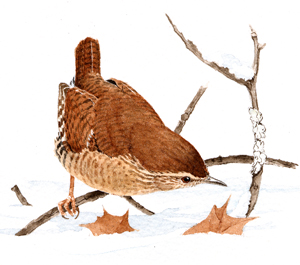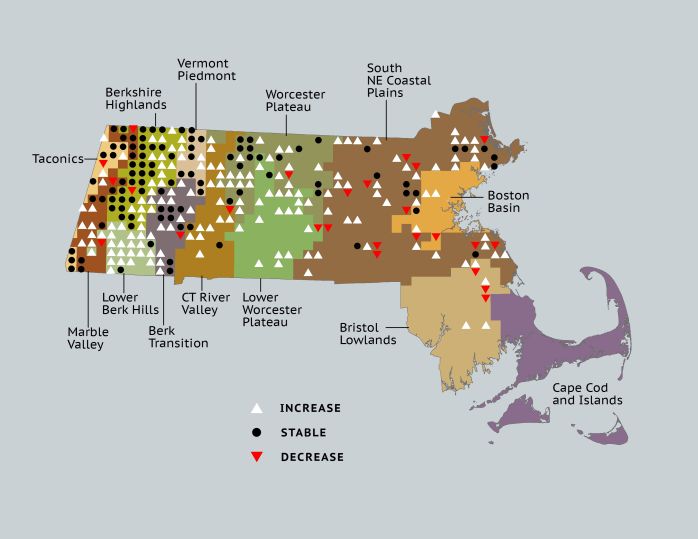Find a Bird
Winter Wren
Troglodytes hiemalis

Somewhat local and strongly increasing

“In the wrens nature nearly achieves perpetual motion.” —Alexander Wetmore, The Book of Birds
The genus of the Winter Wren, Trogolodytes, conjures up images of a brutish, savage, and primitive creature. Winter Wrens, however, are none of these things; rather, they are tiny and elusive birds whose vibrant and ebullient songs have enchanted birders for generations. In fact, throughout the folklore of the Old World, the Winter Wren’s close relative, the Eurasian Wren, is exalted as the king of all birds. The Latin name originates from the wrens’ attraction to holes, crevices, and other cavelike openings in their mature forest habitat.
Historic Status
With the clearing of the land to make room for agriculture it makes sense that the Winter Wren, the “absurd little creature” of the forest, as described by Forbush (Forbush 1929), would have become rare or absent. In 1839, a report to the legislature stated, “The Winter Wren...is inserted in the list of our birds, on the authority of Audubon. It abounds in Maine in summer, but in this State must always be rare” (Peabody 1839). By the 1920s, however, the Winter Wren was breeding sporadically across the western part of the state, but was rarely seen in eastern Massachusetts (Forbush 1929). Nonetheless, at the end of the agricultural era in Massachusetts and by the time the 1970s rolled around Winter Wren breeding activity was occurring statewide.
Atlas 1 Distribution
In Atlas 1, Winter Wrens occupied about 14% of the state and were most widespread in the northwestern corner of the state; in fact, the Taconic Mountains and Berkshire Highlands (both 56% occupancy), and Vermont Piedmont (65% occupancy) had the highest occupancy in the state. Progressively lower densities of Winter Wrens were found moving eastward, with a notable drop in the Connecticut River Valley, likely due to a lack of mature forest in that region. The Worcester Plateau had Winter Wrens in 21% of blocks, four times the occupancy rate of the more southerly Lower Worcester Plateau. Winter Wrens were present but sparsely distributed throughout the Coastal Plains and parts of the Boston Basin, and a few birds made their homes in the mature wet woods of the Bristol/Narragansett Lowlands.
Atlas 2 Distribution and Change
The Winter Wren was one of three wrens to show an increase in breeding distribution across the state. This species differs from both the Carolina Wren and the House Wren in that it is unlikely to ever be found in suburban landscapes – it is a true forest bird. Yet, from the overall increase in blocks occupied statewide, an increase over 17% of the state even when we use the effort-controlled blocks, a review of its status in most regions of the state suggests that the Winter Wren appeared to be thriving. The species held steady in 101 blocks, gained at least 166 new blocks, and only disappeared from 25 blocks statewide, showing remarkable stability and growth. In western and central Massachusetts, Winter Wrens had impressive growth in most regions. Those percentages drop off as you move eastward, but the gains are nonetheless notable.
Atlas 1 Map

Atlas 2 Map

Atlas Change Map

Ecoregion Data
Atlas 1 | Atlas 2 | Change | ||||||
Ecoregion | # Blocks | % Blocks | % of Range | # Blocks | % Blocks | % of Range | Change in # Blocks | Change in % Blocks |
Taconic Mountains | 9 | 56.3 | 6.9 | 15 | 60.0 | 4.3 | 2 | 13.3 |
Marble Valleys/Housatonic Valley | 15 | 38.5 | 11.5 | 20 | 51.3 | 5.8 | 5 | 12.8 |
Berkshire Highlands | 31 | 56.4 | 23.7 | 52 | 94.5 | 15.0 | 19 | 35.8 |
Lower Berkshire Hills | 2 | 7.1 | 1.5 | 25 | 80.6 | 7.2 | 21 | 77.8 |
Vermont Piedmont | 11 | 64.7 | 8.4 | 17 | 100.0 | 4.9 | 3 | 25.0 |
Berkshire Transition | 10 | 26.3 | 7.6 | 29 | 72.5 | 8.4 | 13 | 41.9 |
Connecticut River Valley | 3 | 5.4 | 2.3 | 22 | 33.8 | 6.4 | 12 | 25.0 |
Worcester Plateau | 16 | 20.5 | 12.2 | 72 | 81.8 | 20.8 | 22 | 45.8 |
Lower Worcester Plateau | 4 | 5.4 | 3.1 | 24 | 30.0 | 6.9 | 14 | 25.9 |
S. New England Coastal Plains and Hills | 25 | 9.3 | 19.1 | 62 | 21.9 | 17.9 | 27 | 11.9 |
Boston Basin | 2 | 3.6 | 1.5 | 4 | 7.1 | 1.2 | 2 | 3.6 |
Bristol and Narragansett Lowlands | 3 | 2.8 | 2.3 | 4 | 3.5 | 1.2 | 1 | 1.0 |
Cape Cod and Islands | 0 | 0.0 | 0.0 | 0 | 0.0 | 0.0 | 0 | 0.0 |
Statewide Total | 131 | 13.5 | 100.0 | 346 | 33.4 | 100.0 | 141 | 17.0 |
Notes
Maturing forests would seem to be the likely driver of the gains observed in the west, central, and northeast portions of the state. But the Winter Wren’s dependence on complex forest floor vegetation, and the threat to that part of forest vegetation structure due to deer browse, could someday limit or halt the spread of the Winter Wren’s recovery.



